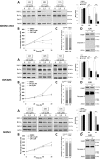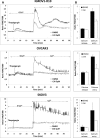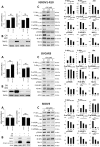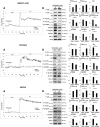Inhibition of store-operated channels by carboxyamidotriazole sensitizes ovarian carcinoma cells to anti-BclxL strategies through Mcl-1 down-regulation
- PMID: 30338034
- PMCID: PMC6188062
- DOI: 10.18632/oncotarget.26084
Inhibition of store-operated channels by carboxyamidotriazole sensitizes ovarian carcinoma cells to anti-BclxL strategies through Mcl-1 down-regulation
Abstract
The anti-apoptotic proteins Bcl-xL and Mcl-1 have been identified to play a pivotal role in apoptosis resistance in ovarian cancer and constitute key targets for innovative therapeutic strategies. Although BH3-mimetics (i.e. ABT-737) potently inhibit Bcl-xL activity, targeting Mcl-1 remains a hurdle to the success of these strategies. Calcium signaling is profoundly remodeled during carcinogenesis and was reported to activate the signaling pathway controlling Mcl-1 expression. In this context, we investigated the effect of carboxyamidotriazole (CAI), a calcium channel inhibitor used in clinical trials, on Mcl-1 expression. CAI had an anti-proliferative effect on ovarian carcinoma cell lines and strongly down-regulated Mcl-1 expression. It inhibited store-operated calcium entry (SOCE) and Mcl-1 translation through mTORC1 deactivation. Moreover, it sensitized ovarian carcinoma cells to anti-Bcl-xL strategies as their combination elicited massive apoptosis. Its effect on mTORC1 and Mcl-1 was mimicked by the potent SOCE inhibitor, YM58483, which also triggered apoptosis when combined with ABT-737. As a whole, this study suggests that CAI sensitizes to anti-Bcl-xL strategies via its action on Mcl-1 translation and that modulation of SOCE could extend the therapeutic arsenal for treatment of ovarian carcinoma.
Keywords: ABT-737; MCL-1; Store-operated calcium channels; mTORC1; ovarian cancer.
Conflict of interest statement
CONFLICTS OF INTEREST The authors declare no conflicts of interest.
Figures





Similar articles
-
Calcium signals inhibition sensitizes ovarian carcinoma cells to anti-Bcl-xL strategies through Mcl-1 down-regulation.Apoptosis. 2015 Apr;20(4):535-50. doi: 10.1007/s10495-015-1095-3. Apoptosis. 2015. PMID: 25627260 Free PMC article.
-
The mTORC1/2 Inhibitor AZD8055 Strengthens the Efficiency of the MEK Inhibitor Trametinib to Reduce the Mcl-1/[Bim and Puma] ratio and to Sensitize Ovarian Carcinoma Cells to ABT-737.Mol Cancer Ther. 2017 Jan;16(1):102-115. doi: 10.1158/1535-7163.MCT-16-0342. Epub 2016 Dec 15. Mol Cancer Ther. 2017. PMID: 27980105
-
Dual inhibition of anti-apoptotic proteins BCL-XL and MCL-1 enhances cytotoxicity of Nasopharyngeal carcinoma cells.Discov Oncol. 2022 Feb 3;13(1):9. doi: 10.1007/s12672-022-00470-9. Discov Oncol. 2022. PMID: 35201512 Free PMC article.
-
Recent Advances in Cancer Drug Development: Targeting Induced Myeloid Cell Leukemia-1 (Mcl-1) Differentiation Protein.Curr Med Chem. 2017;24(40):4488-4514. doi: 10.2174/0929867324666170912092659. Curr Med Chem. 2017. PMID: 28901269 Review.
-
The first MCL-1-selective BH3 mimetics have therapeutic potential for chronic lymphocytic leukemia.Crit Rev Oncol Hematol. 2016 Apr;100:32-6. doi: 10.1016/j.critrevonc.2016.02.003. Epub 2016 Feb 11. Crit Rev Oncol Hematol. 2016. PMID: 26899021 Review.
Cited by
-
Bim, Puma and Noxa upregulation by Naftopidil sensitizes ovarian cancer to the BH3-mimetic ABT-737 and the MEK inhibitor Trametinib.Cell Death Dis. 2020 May 18;11(5):380. doi: 10.1038/s41419-020-2588-8. Cell Death Dis. 2020. PMID: 32424251 Free PMC article.
-
Quantum Computational Investigation of (E)-1-(4-methoxyphenyl)-5-methyl-N'-(3-phenoxybenzylidene)-1H-1,2,3-triazole-4-carbohydrazide.Molecules. 2022 Mar 28;27(7):2193. doi: 10.3390/molecules27072193. Molecules. 2022. PMID: 35408592 Free PMC article.
-
ORAI1 inhibition as an efficient preclinical therapy for tubular aggregate myopathy and Stormorken syndrome.JCI Insight. 2024 Mar 5;9(6):e174866. doi: 10.1172/jci.insight.174866. JCI Insight. 2024. PMID: 38516893 Free PMC article.
-
Synthesis and Antiproliferative Activity of Triazoles Based on 2-Azabicycloalkanes.Materials (Basel). 2021 Apr 18;14(8):2039. doi: 10.3390/ma14082039. Materials (Basel). 2021. PMID: 33919613 Free PMC article.
-
Side-by-side comparison of published small molecule inhibitors against thapsigargin-induced store-operated Ca2+ entry in HEK293 cells.PLoS One. 2024 Jan 23;19(1):e0296065. doi: 10.1371/journal.pone.0296065. eCollection 2024. PLoS One. 2024. PMID: 38261554 Free PMC article.
References
-
- Siegel RL, Miller KD, Jemal A. Cancer Statistics, 2017. CA Cancer J Clin. 2017;67:7–30. - PubMed
-
- Ledermann JA, Raja FA, Fotopoulou C, Gonzalez-Martin A, Colombo N, Sessa C, ESMO Guidelines Working Group Newly diagnosed and relapsed epithelial ovarian carcinoma: ESMO Clinical Practice Guidelines for diagnosis, treatment and follow-up. Ann Oncol. 2013;24(Suppl 6):vi24–32. - PubMed
-
- Hanahan D, Weinberg RA. Hallmarks of cancer: the next generation. Cell. 2011;144:646–74. - PubMed
-
- Juin P, Geneste O, Gautier F, Depil S, Campone M. Decoding and unlocking the BCL-2 dependency of cancer cells. Nat Rev Cancer. 2013;13:455–65. - PubMed
-
- Gloaguen C, Voisin-Chiret AS, Sopkova-de Oliveira Santos J, Fogha J, Gautier F, De Giorgi M, Burzicki G, Perato S, Pétigny-Lechartier C, Simonin-Le Jeune K, Brotin E, Goux D, N'Diaye M, et al. First evidence that oligopyridines, α-helix foldamers, inhibit Mcl-1 and sensitize ovarian carcinoma cells to Bcl-xL-targeting strategies. J Med Chem. 2015;58:1644–68. - PubMed
LinkOut - more resources
Full Text Sources
Other Literature Sources
Research Materials

